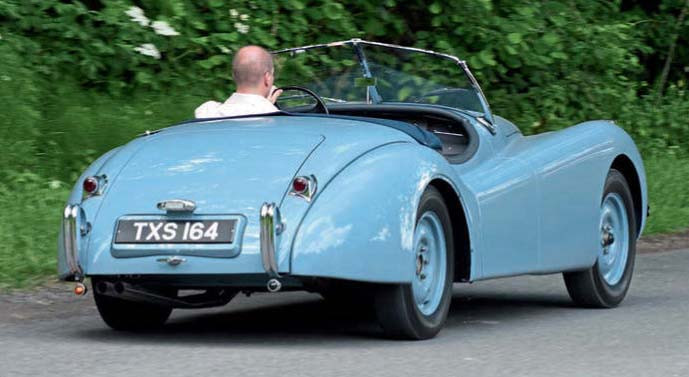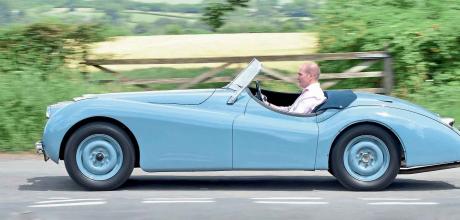1952 Jaguar XK120 Racer
This Jaguar XK120 was raced in the 1952 International Race of Champions at Silverstone by Prince Bira and after a life in the USA the recently restored car has returned to the UK.
WORDS & PHOTOGRAPHY PAUL WALTON
Fit for a prince XK120 RACER
An XK120 with an impeccable provenance going right back to the 1952 Race of Champions.
The XK120 might have been coming to the end of its life by 1952 but when the British Racing Drivers’ Club was arranging that year's International Race of Champions at Silverstone on May 10, it still chose six identical examples of the now four-year-old car for the five-lap celebrity race.

The cars might have been the same, but the drivers the BRDC had invited were a varied bunch, including: Johnny Claes, a British born Belgian who together with Jacques Ickx had won the 1951 Rome-Liege-Rome with an XK120 Baron Emmanuel de Graffenried, a Swiss Formula 1 driver and winner of the 1949 British Grand Prix Paul Pietsch, a German driver who finished third at the 1935 Italian Grand Prix for Auto Union Tony Gaze, the first Australian to take part in a Formula1World Championship race when he finished 15th in the 1952 Belgian Grand Prix in an HWM-Alta Stirling Moss, the then 22-year-old British driver who had already won the 1950 Tourist Trophy in an XK120 a feat that secured him a contract with Jaguar B. Bira from Thailand who’d enjoyed plenty of pre-war success The latter was actually a nom de plume for Prince Birabongse Bhanudej Bhanubandh, a member of the Siam (now Thai) royal family and a cousin of King Rama VIII. He first came to the UK in 1927 to study at Eton College and started competing at the Brooklands circuit eight years later, originally with a Riley Imp which was followed by anMGK-Type Magnette.

He’s more famous for driving an ERA called Romulus which was given to him by his cousin, Chula, for his 21st birthday on 21 July 1935. After buying another ERA in 1936 (Remus) Chula started his White Mouse Stable team which later employed a young Frank ‘Lofty’ England who, two decades later, would become Jaguar’s competition manager. The cars were distinctive in their light blue and bright yellow colour scheme which was apparently inspired by the dress of a Scandinavian woman Bira once met but later became Siam (and therefore Thailand’s) official racing colours. Driving under the B. Bira name, the young prince was competitive, winning several important races including the 1936 Monaco Grand Prix.

Despite Thailand being officially at war with the UK due to it being under Japanese occupation at the time, Bira stayed in the country, joining the Home Guard. Because of his interest in gliders, he became an instructor with the Air Training Corps which was part of the RAF. He started racing again soon after hostilities had ended, initially with his ERA and a Maserati 4CL but later with a newer 4CLT owned by an independent Italian team, Scuderia Platé. He finished fifth and then fourth at the 1950 Monaco and Swiss Grand Prix respectively, earning him five points in the newly introduced Formula 1 World Championship. A keen sailor, after retiring from motorsport in 1955, Bira represented Thailand four times in the summer Olympic Games between 1956 to 1972 Bira had earlier been asked to race the XK120 for its competition debut, the International Trophy Race at Silverstone in August 1949. Driving the first example built (660001) that had been displayed at the Earls Court Motor Show the year before, he sadly retired due to a puncture. Three years later he was back in an XK120 for the International Race of Champions representing Thailand.

No doubt pleased with the publicity the event would give the ageing car, Jaguar had agreed to supply six identical left-hand- drive XK120s which had all been built between March and April 1952. To create an element of surprise and unpredictability, the drivers then drew lots as to which one they would drive, with Bira getting chassis 672063, a light blue example with a contrasting light and dark blue interior.

According to Stirling Moss’ 1985 biography,My Cars, My Career, “We were given just enough practice to get the feel of the cars and then raced for five laps.” He went on to write that with the majority of the grid making their names before the war – including Bira – he wasn’t troubled for the lead. “I had a fairly easy win,”was his laconic description of the race.

“Moss proved his great virtuosity by running clean away, winning from the Baron by 11 sec,” was Motor Sport magazine’s view in its June 1952 issue. After winning the Formula 3 race with his Kieft-Norton 500, followed by touring car race with a Jaguar MkVII and then the Production Sports Car Race in a C-type, this was Moss’s fourth victory of the day. Bira finished fourth, just behind Pietsch. With the race over, the six cars were returned to Browns Lane and later shipped to the States ready to be sold, their albeit brief racing career not registered. What had been Bira’s car was apparently despatched on 30 May, 1952 and sold through Charles Hornburg’s dealership in Los Angeles. Although the car’s early years aren’t known, its entry of the 1952 International Race of Champions was eventually recognised and it spent 35 years as part of a prestigious US collection of classic cars. The Jaguar returned to the UK in early 2023 when it was given a full mechanical rebuild that included swapping the original gearbox for a modern five-speed transmission and is currently for sale through JD Classics in Chelmsford. Although pale blue isn’t the first colour you’d think of for a racing XK120, it still looks resplendent, the elegant hue suiting the car’s long and graceful lines.

Yet the steel wheels minus their chrome embellishments plus the lack of rear spats give the car more of a muscular and sporty appearance than normal. It’s not difficult to imagine Bira lining up on the grid in the XK120, the 39-year-old no doubt eyeing the young Moss in an identical car as the main contender. When I open the low-slung door that offers as much protection as a paper bag would in a hurricane and clamber aboard, the smaller diameter of the after-market steering wheel than the 17in original making ingress easier, the interior is both comfortable yet basic. The centrally located dash consists of just five dials plus one chrome switch for the lights. There isn’t even a radio but I soon realise I don’t need one.
The 3.4-litre straight six engine bursts enthusiastically into life the moment I press the starter button, the characteristic growl of the twin cam sounding better than any FM station ever could. The five-speed box slots smoothly into first and the car moves forward with an ease I wasn’t expecting. On the long and empty country roads available to us, I bury the pedal hard, the engine responding with a sudden burst of acceleration, revving long and hard before I finally need to change up. Unlike the often hard-to-use Moss box it would have been fitted with when Bira drove the car, the changes are slick and accurate and I’m soon blasting through the green lanes, the sound the XK unit ricocheting off the trees.
With surprisingly sharp and accurate steering, after a clean change down to third, I’m able to balance the throttle in preparation for an approaching long bend. With the skinny tyres at the edge of their adhesion, I nail the pedal on the exit just as Bira would done at Woodcote or Copse causing the blue Jaguar to once again surge forward. Although this XK120 saw less action than others of the era such as HKV500, the first to win a race in 1949 and later used for the 1950 Tourist Trophy and 1951 Mille Miglia, or Ian Appleyard’s famous rally winning NUB120, its eagerness to accelerate shows it’s still clearly a racer at heart. The XK120 might have been four years old at the time of the 1952 Race of Champions but judging by the performance of this one of the six that took part, it remained the perfect choice for such events and genuinely fit for a prince.
Thanks to: JD Classics (woodham-mortimer.com) and The Ferrari House
Prince Bira in the blue XK120 during the 1952 Race of Champions at Silverstone
Standard Jaguar XK engine now drives though a modern five speed gearbox


